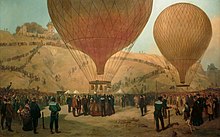Léon Gambetta
Léon Gambetta (born April 2, 1838 in Cahors , † December 31, 1882 in Ville-d'Avray near Paris ) was a French statesman of the Third Republic .
Life
Gambetta was the son of a Genoese merchant who immigrated to France and a Gascognischen mother. At the age of 15, Gambetta lost his right eye while watching a cutler and being hit by a broken drill bit. Gambetta took French citizenship in 1859 . From 1857 to 1860 he studied law in Paris, received the 'License en droit en France' and became a lawyer. When he defended the journalist Charles Delescluze in a court case in 1868 , he became known as an opponent of the Second Empire . In 1869 he was accepted into the Freemasons ' League in the La Réforme Lodge in Marseille .
In 1869 he won a seat in the National Assembly . During the election campaign, he helped formulate the “Belleville Program”, which, with its far-reaching demands for freedoms, became the fundamental manifesto of the radical left. In parliament, Gambetta joined the republican minority who opposed the Franco-Prussian War of 1870.
With Jules Favre , Léon Gambetta called on September 4, 1870, after the defeat at Sedan and the abdication of Napoleon III. , formed the “ Third Republic ” in Paris and became its first interior minister . On October 7, 1870, he was appointed by the Government of National Defense to direct the war in the province. Gambetta then left besieged Paris in a balloon, but his plan to liberate the capital failed. In Tours he organized a new government which was to meet in Bordeaux .
When Paris surrendered on January 28, 1871, Gambetta advocated continuing the war. Adolphe Thiers therefore called him fou furieux (angry madman). Eventually Gambetta had to accept the armistice and resigned from his government office on February 6, 1871. After the war, Gambetta was a firm advocate of revanchism towards Germany and coined the phrase: "Toujours y penser, jamais en parler." ("Always remember, never talk about it!")
In the National Assembly he represented the Bas-Rhin department in Alsace from February 8 to March 1, 1871 ; after the annexation by the Germans, he gave back his mandate in protest. He retired to Spain and Switzerland for a few months and was elected on July 2, 1871, as a member of the Seine department . In the largely monarchist-minded parliament he was the most important representative of the small republican opposition, the party of the "radicals". Increasingly, he represented more moderate positions, which he contributed to the passing of the constitutional laws of 1875 and 1877/1878 to overthrow President Mac-Mahon .
From 1879 to 1881 he was President of the Chamber and from November 14, 1881 to January 27, 1882 President of the Council of Ministers (Prime Minister) . Practically at the same time he also served as foreign minister . His government, which had to rely on the far left and right, was overthrown because of Gambetta's attempt to introduce a list voting system.

He was injured in the hand - according to official reports while he was repairing his pistol , possibly by his lover, Léonie Léon - and died of blood poisoning a few days later at the age of 44.
On November 11, 1920, Gambetta's heart was transferred to the Panthéon , the same day that the tomb of the unknown soldier was erected under the triumphal arch .
literature
- Pierre Antonmattei: Léon Gambetta, héraut de la République . Michalon, Paris 1999, ISBN 2-84186-100-7 .
- Pierre Barral: Léon Gambetta. Triibun et stratège de la République (1838 - 1882) . Private, Toulouse 2008, ISBN 978-2-7089-6889-9 .
- Colmar von der Goltz : Léon Gambetta and his armies . F. Schneider & Co., Berlin 1877 ( digitized version )
- Jean-Marie Mayeur: Léon Gambetta. La patrie et la République . Fayard, Paris 2008, ISBN 978-2-213-60759-7 .
- Daniel Mollenhauer: In search of the "real republic". The French »radicaux« in the early Third Republic (1870–1890) . (Paris Historical Studies, 46). Bouvier, Bonn 1997, ISBN 3-416-02783-3 ( digitized version )
- Kurt Lothar Tank: Gambetta. A political fighter against despotism and the like. Anarchy . Essen Publishing House, Essen 1937
- Kurt Lothar Tank: Gambetta as a publicist. His fight against the Second Empire from 1860 to 1870 . Essen publishing house 1937
- Kurt Lothar Tank : France between freedom and dictatorship. Gambetta's fight against Napoleon III. Holsten-Verlag, Hamburg 1958
- Eduard Schmidt-Weißenfels : The standard bearer of the French Republic . In: The Gazebo . Issue 1, 1878, pp. 15-19 ( full text [ Wikisource ]).
Web links
- Literature by and about Léon Gambetta in the catalog of the German National Library
- Caricatures by Léon Gambetta in HeidICON
Individual evidence
- ↑ Jürgen Holtorf: The lodges of the Freemasons, Nikol Verlags GmbH, Hamburg ISBN 3-930656-58-2 p. 145
- ↑ Constitutional law on the organization of French state power of February 25, 1875 - on the site there are links to the constitution of the Senate of February 24 and the French authorities among themselves from July 16, 1875
| personal data | |
|---|---|
| SURNAME | Gambetta, Léon |
| BRIEF DESCRIPTION | French statesman of the Third Republic |
| DATE OF BIRTH | April 2, 1838 |
| PLACE OF BIRTH | Cahors |
| DATE OF DEATH | December 31, 1882 |
| Place of death | Ville-d'Avray |



